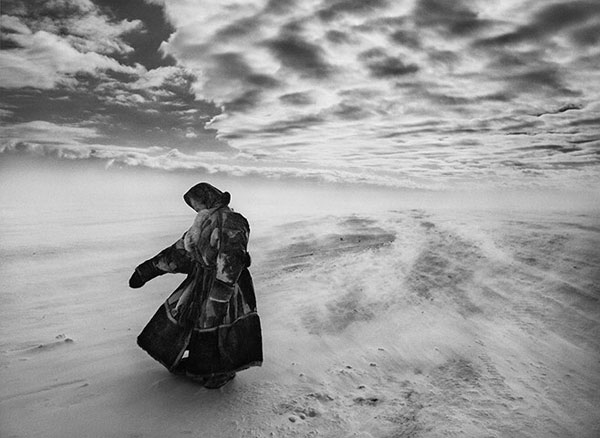The modern world is a rush of industry, traffic, and whirring machinery. In 1932 Aldous Huxley predicted a ‘a brave new world’, but Sebastião Salgado has documented the striking existence of indigenous populations that have escaped the industrial buzz. Genesis is a collection of photographs that capture wildlife, nature and people in pockets of the world that survive on the grains of the earth, rather than the processes of technology. From Arizona to Siberia, Salgado travelled to 32 countries over eight years to study and photograph ethnic communities in a world that appears so very far from our own.
The black and white images showcase the wide expanse of magnificent untouched landscapes, as well as the humility of living a life sans cars, roads, or even a microwave. In the photographs below, Salgado illustrates how the Nenets – a nomadic population from northern Siberia – negotiate living in the frosty conditions of a ubiquitous Siberian winter. With reindeers and sleds replacing cars, and cemented houses being swapped for tents, the photographs narrate the unexpected survival of nature and tradition in an increasingly progressive universe.
As a nomadic culture, movement is crucial for the endurance of Nenet traditions. Yet without cars, planes, or trains, the harsh winds and bitter cold can leave the Nenets suspended in their travels until conditions lull. They rest in tents called tchoum, which are constructed from wood and covered with reindeer skin for warmth and protection. Reindeer hide is also used as a source of clothing and on days when the weather is reasonably pacified, the Nenets move forward to cross the Orb River and enter the Arctic Circle.
Genesis is not Salgado’s first attempt to explore and evoke social commentary through photography. The award-winning photojournalist garnered success and acclaim for two previous collections: Workers and Migrations. Genesis is an extension of Salgado’s endeavour to snap and reveal the hidden corners of our global labyrinth.
The pictures may inspire a sense of loss for the natural beauty that has been taken by urban development. Yet for Salgado the photographs are a celebration of what he calls ‘nature’s unspoiled legacy’. He describes Genesis as a ‘depiction of the lands and lives of a still pristine planet’. The Brazilian goes on to say:
I feel Genesis also speaks urgently to our own age by portraying the breathtaking beauty of a lost world that somehow survives. It proclaims: this is what is in peril, this is what we must save.
words: Raeesa
all images by Sebastião Salgado, taken from: guardian.co.uk


















1 comment
Exklusiv: Genesis von Sebastiao Salgado | street62.de – dokumentarfotografie.com says:
Mar 17, 2013
[…] zeigt über die Suchfunktion schon jetzt einige der Fotos und Artikel dazu entstehen fast […]